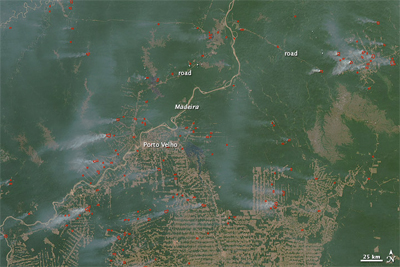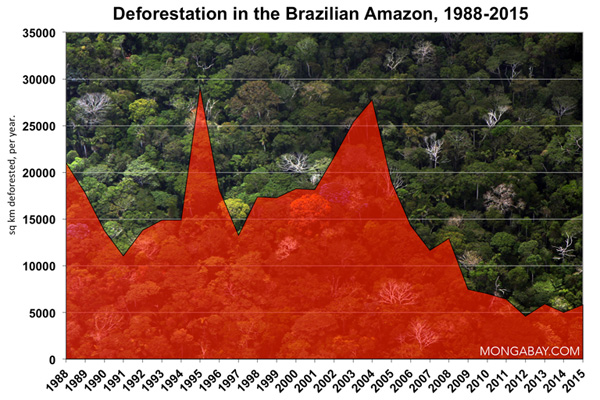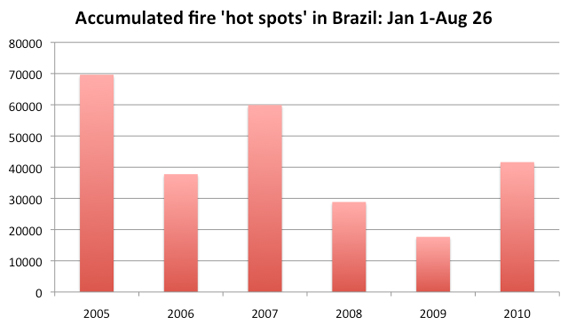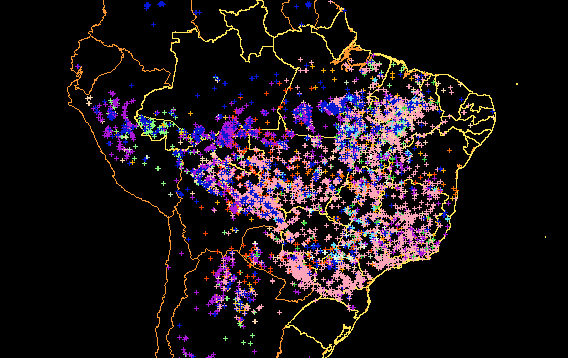The number of fires burning in Brazil more than doubled compared with the same period last year. Surprisingly, the news has sparked a Twitter sensation, with more than 120,000 users “tweeting” messages with the hashtag “#chegadequeimadas” about the fires in a 48 hour window.
The phenomenon emerged after analysis of satellite data by Brazil’s National Institute for Space Research (INPE) revealed the number of “hot spots” between Jan 1 and Aug 26 reached 41,636 in 2010, up from 17,682 for the same period last year.
Alberto Setzer, coordinator of INPE’s fire monitoring program, blamed drier and warmer conditions, as well as socio-political factors, like higher commodity prices and upcoming national elections. Afraid of alienating key supporters in the agricultural sector, Setzer told Terra Brasil that politicians are laying off environmental law enforcement under after elections. Uncertainty about the Brazilian environmental legislation – including a possible weakening of the country’s strict Forest Code – might also be having an impact.
 On August 7, 2010, fires burned along the Madeira River in the vicinity of Porto Velho, the capital of Rondônia, Brazil. The Moderate Resolution Imaging Spectroradiometer (MODIS) on NASA’s Aqua satellite captured this natural-color image the same day. Red outlines indicate high surface temperatures associated with actively burning fires, and pale gray smoke plumes arise from most of the hotspots. At first glance, the placement of the fires might appear random, but a close look indicates that the fires burn close to cleared lands, particularly near roads. The characteristic herringbone pattern of deforestation spreads across much of this image, especially in the south. Many of the fires burn along the fringes of such cleared areas. NASA image by Jeff Schmaltz, MODIS Rapid Response Team. Caption by Michon Scott. |
Fires in the Brazilian Amazon are generally set by developers opening logged forests, deforested scrub, and grassland for pasture and agriculture. Under dry conditions fires often “escape” into adjacent rainforest areas, casting a pall over much of Brazil and in some years affecting transportation and air quality. Fires usually burn until September or October when the rainy season resumes. This year fires are especially concentrated in the drier, but more populated, northeastern and southern parts of the country.
Despite the rise in burning, deforestation in the Brazilian Amazon is expected to be roughly the same as last year — around 7,000 square kilometers — when figures are released later this year. If the forecast is correct, it will continue a trend of markedly lower deforestation than levels seen from the 1980s until about five years ago.
Nevertheless environmentalists fear that a suite of proposed infrastructure projects could accelerate deforestation in the future despite a pledge by the Brazilian government to reduce deforestation significantly by 2018.
Brazil contains the bulk of the world’s remaining tropical rainforest, but substantial parts of the country are covered with cerrado grassland, which is more susceptible to fire than forest.


INPE data on accumulated burning, 2005-2010

Fire hotspots across South America, 2010
Related articles
Brazil’s plan to save the Amazon rainforest

(06/02/2009) Accounting for roughly half of tropical deforestation between 2000 and 2005, Brazil is the most important supply-side player when it comes to developing a climate framework that includes reducing emissions from deforestation and forest degradation (REDD). But Brazil’s position on REDD contrasts with proposals put forth by other tropical forest countries, including the Coalition for Rainforest Nations, a negotiating block of 15 countries. Instead of advocating a market-based approach to REDD, where credits generated from forest conservation would be traded between countries, Brazil is calling for a giant fund financed with donations from industrialized nations. Contributors would not be eligible for carbon credits that could be used to meet emission reduction obligations under a binding climate treaty.
How to save the Amazon rainforest
(01/04/2009) Environmentalists have long voiced concern over the vanishing Amazon rainforest, but they haven’t been particularly effective at slowing forest loss. In fact, despite the hundreds of millions of dollars in donor funds that have flowed into the region since 2000 and the establishment of more than 100 million hectares of protected areas since 2002, average annual deforestation rates have increased since the 1990s, peaking at 73,785 square kilometers (28,488 square miles) of forest loss between 2002 and 2004. With land prices fast appreciating, cattle ranching and industrial soy farms expanding, and billions of dollars’ worth of new infrastructure projects in the works, development pressure on the Amazon is expected to accelerate. Given these trends, it is apparent that conservation efforts alone will not determine the fate of the Amazon or other rainforests. Some argue that market measures, which value forests for the ecosystem services they provide as well as reward developers for environmental performance, will be the key to saving the Amazon from large-scale destruction. In the end it may be the very markets currently driving deforestation that save forests.
Future threats to the Amazon rainforest
(07/31/2008) Between June 2000 and June 2008, more than 150,000 square kilometers of rainforest were cleared in the Brazilian Amazon. While deforestation rates have slowed since 2004, forest loss is expected to continue for the foreseeable future. This is a look at past, current and potential future drivers of deforestation in the Brazilian Amazon.